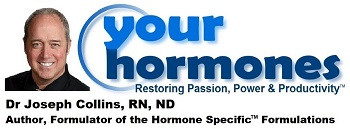
Proper Use of Hormone Precursors by Joseph J Collins, RN, ND
The term "hormone precursors" is usually used to describe non-prescription hormones such as pregnenolone, DHEA and 7-KETO-DHEA. They may be used if the body is not able to adequately respond to lifestyle, diet, nutritional support, proper essential fatty acids (omega-3 oils) and proper herbal therapies (the Hormone Specific Formulations™). In truth, it is not a good idea to use pregnenolone, DHEA and 7-KETO-DHEA until the body is healthy enough to use them properly. Before considering the use of pregnenolone, DHEA and 7-KETO-DHEA make sure that the patient has consistently adhered to recommendations in the Foundations of Hormone Health and the proper use of Hormone Specific Formulations™.
In reality, pregnenolone, DHEA are not only precursor for other hormones, but pregnenolone and DHEA each have important metabolic functions in and of themselves, even if they are not converted to other hormones. And 7-KETO-DHEA is actually a metabolite – and not really a precursor. Each of these supplements are available without a prescription.
Pregnenolone is often referred to as the grandparent precursor to the other steroid hormones. Pregnenolone is primarily synthesized from cholesterol in the mitochondria of the adrenal glands. Pregnenolone is also made to a lesser extent in the brain, liver, skin, testes and ovaries. Once synthesized, pregnenolone may be converted to DHEA (dehydroepiandrosterone) or to progesterone. DHEA serves as a precursor compound to the androgens and the estrogens through androstenedione as the intermediate compound. Progesterone is the precursor to cortisol, aldosterone, androstenedione, estrogen, and testosterone. Pregnenolone has many actions of its own not attributable to its conversion to progesterone or to DHEA. Pregnenolone is important for the function of brain, nervous tissue, liver, pancreas, reproductive tissues, pituitary and skin. Pregnenolone is found in higher concentrations in the central nervous system compared to the peripheral tissues which may reflect its importance in brain function. As with many hormones, pregnenolone production declines with age. It is estimated that pregnenolone production is about 60% less at age 75 than at age 35. Pregnenolone levels may also decline under various conditions of physiological stress, such as acute and chronic infections and trauma.
DHEA (dehydroepiandrosterone) is a natural steroid hormone that is synthesized from cholesterol through pregnenolone by the adrenal glands. DHEA acts as an antagonist for cortisol and other glucocorticosteroid hormones. DHEA is also the precursor for other important steroid hormones, such as estradiol and other estrogens, and testosterone. DHEA also has important biological functions itself. Recent experimental and human studies show that DHEA is involved in a large variety of physiological processes, including immune function, brain function, bone metabolism, blood lipid metabolism, energy metabolism, the regulation of normal blood sugar and insulin levels, and the maintenance of lean body mass. DHEA sulfate levels are low in early childhood and begin to rise after age 7. The levels peak at age 20-24, and then drop at a rate of approximately 20% per decade. At 85-90 years of age, DHEA levels are 10-15% of what they used to be at age 20-30. DHEA levels also decline under a variety of conditions of physiological stress, such as acute and chronic infections, and trauma. Vegetarians have been shown to have decreased DHEA levels as well.
Unlike 7-KETO-DHEA, both pregnenolone and DHEA can potentially become other hormones – the operative word being “potentially” – there is no guarantee what they will become, or what hormone levels will increase. Both pregnenolone and DHEA may help increase testosterone, but may also increase estrogens, such as estradiol and estrone. Even though they are each commonly referred to as “hormone precursors”, these supplements may or may not be converted to more potent hormones such as testosterone or estrone, or estradiol. They may just stay pregnenolone or DHEA. This may not be a problem because even if they are not converted, they still have actions of their own. For example, if DHEA (an important hormone from the adrenal glands) levels are low, we want to simply increase DHEA, and may not want it to become something else.
Increase testosterone by using pregnenolone or DHEA with EstroQuench™, which will decrease the conversion of pregnenolone or DHEA into estrogen.
Increase progesterone by using pregnenolone with ProgestoMend™, which has herbs to increase adrenal and luteal production of progesterone. If there has been a problem with too much estrogen production (estrogen dominance), also use EstroQuench™ to help make more progesterone.
Increase estrogen without increasing testosterone in women by using pregnenolone or DHEA with TestoQuench™ for Women, which has herbs to decrease testosterone production but increase estrogen production.
As noted, it is important to adhere to recommendations in the Foundations of Hormone Health when using pregenolone, DHEA, 7-Keto-DHEA or any of the Hormone Specific Formulations™.
7-Keto-DHEA (3-acetyl-7-oxo-dehydroepiandrosterone) is actually a DHEA metabolite and cannot convert back into DHEA in the body. It is not converted to testosterone or estrogens, but it has beneficial properties of its own, such as increasing metabolism by thermogenesis (fat burning) activity. It is several times more potent than DHEA in stimulating the thermogenic enzymes of the liver, promotes basal metabolism, and helps to increase the lean/adipose ratio. It may also support memory and cognitive function and enhance immune function by preventing age-related decreases of immune function. As humans age, natural levels of 7-Keto-DHEA begin to decline and may have an effect on the body’s ability to maintain optimum thermogenesis (fat burning) activity.
Becoming Other Hormones
DOSAGE GUIDELINES
DHEA dosages for men may start at one DHEA (25 mg) each AM. The dosage may be increased to one or even two of the DHEA 50 mg capsules if indicated (by lab tests), but keep in mind that the higher the dosage of DHEA, the more likely that it will become estrogens. Using TestoGain™ will encourage the body to convert more DHEA to testosterone. In men, it is very important that DHEA, estrogen and testosterone levels all be monitored before and after starting DHEA, to make sure the estrogens do not become elevated. DHEA is more likely to become estrogens in men with excessive body weight or liver disease. So, it is really a good idea to be on EstroQuench™ before starting DHEA.
DHEA dosage for women should start at DHEA 5 Sublingual (which can also eb swallowed) each AM. It may be increased to one or even two of the DHEA 10 mg capsules up to 20 mg for short periods of time. However, in some women, if more than 5 to 10 mg is given for too long the androgenic effects (acne, oily skin, hair growth) may start to be a problem. In women, it is very important that DHEA, estrogen, progesterone and testosterone levels all be monitored before and after starting DHEA, to make sure the hormones do not become imbalanced. If the DHEA is being used to help raise testosterone and/or estrogen, then women may consider using TestoGain™ and/or EstroMend™ as indicated.
Pregnenolone dosage for both men and women can be 2 ½ mg to 25 mg a day, but typically, it is best to keep it at or below 10 mg. If higher dosages are indicated, based on laboratory tests, it is best to start with a low dosage and work it up slowly over of time. High dosages can make a person irritable or anxious, or cause headaches or heart palpitations. Each person reacts differently to dosages to increase slowly – it does not take much. Women can take ProgestoMend™ with Pregenenolone to encourage the body to convert more pregenolone to progesterone.
7-KETO-DHEA dosage can be as 7-KETO (100 mg) a day. This is a significant dosage, but not as high as the 200 mg dosage that was shown to be safe in males during a 4 week study. As noted, lifestyle, diet, nutritional support, essential fatty acids and Hormone Specific Formulations™ should first be addressed before trying 7-KETO. The ability of 7-KETO-DHEA to stimulate the metabolism may be too much if the body does not have optimal nutrition including fatty acids – and enough magnesium (to keep the heart calm with the increased metabolism). Since 7-KETO-DHEA has androgenic (masculinizing) properties in and of itself women should lower the dosage or stop if acne or oily skin develop.
Summary of Proper Use of Hormone Precursors
Many people are able to achieve optimal hormone with hormone precursors as they have made healthy lifestyle, diet, nutritional support and essential fatty acids choices, and use the appropriate Hormone Specific Formulations™, and appropriate dosages of DHEA, pregnenolone and/or 7-Keto-DHEA.
In some patients Bio-identical Hormone Replacement Therapy (BHRT) may be required. The ideal time to consider BHRT is when restoration of function, as discussed in the Hormone Health series of articles, cannot be attained. Ideally, the patient will have done all that is possible to achieve optimal health before starting BHRT, so that the BHRT will be more effective.
Many people are able to acheive A significant Prescription bioidentical hormone replacement therapies should be considered if, lifestyle, diet, nutritional support, essential fatty acids, Hormone Specific Formulations™, and precursors are unable to restore optimal hormone function. If BHRT is used, please see the series of articles on Bio-identical Hormone Replacement Therapy.
